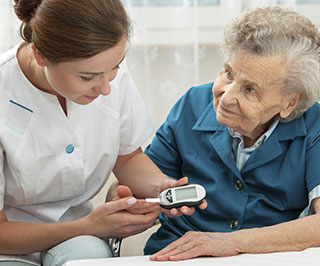 Image credit: AlexRaths/Thinkstockphotos.com
Image credit: AlexRaths/Thinkstockphotos.com
Research suggests it’s difficult for elderly patients to manage their diabetes on multiple levels. A report published in Diabetes Care found that just one-third of elderly diabetics met targets for three measures of diabetic control.
Even under less stringent targets for diabetes risk factors, it appears that many older diabetics have problems managing their condition, researchers found. In another disconcerting finding, the ability to control this disease was especially poor among black women.
“There is tremendous debate about appropriate clinical targets for diabetes in older adults, particularly for glucose control. Are some older adults being overtreated? Are some being undertreated? These are questions for which we don't have answers,” said the study’s lead author, Elizabeth Selvin, PhD, MPH, a professor of epidemiology at the Johns Hopkins University Bloomberg School of Public Health, in a statement. “This research gives us a good picture of diabetes control in older adults and gets us thinking about what it means that older Americans are not meeting clinical targets and how we should address this from a public health perspective.”
To determine how well this age group controls their diabetes, researchers drew from Atherosclerosis Risk in Communities Study (ARIC) data, a study that for nearly 30 years had been tracking a community-based cohort of 15,792 middle-aged adults in four states. The cross-sectional study specifically focused on 1,574 subjects between the ages of 67 and 89 who had diabetes, and were attending their fifth ARIC study visit from 2011 to 2013.
Targets set by the American Diabetes Association (ADA) on three key measures of diabetes control include: below 7% for hemoglobin A1c (HbA1c); under 100 mg/dL for low-density lipoprotein cholesterol (LDL-C); and under 140/90 mmHg for blood pressure. In assessing these targets among the test subjects, researchers determined that more than 70% met the blood pressure and HbA1c goals, while 63% met the target for LDL-C.
Collectively, however, just 35% of these individuals with diabetes achieved all three measures for good diabetes control. Results improved slightly once these targets were loosened to less desirable levels (under 8% for HbA1c, under 150/90 mmHg for blood pressure, and 130 mg/dL for LDL-C), with 90%, 87% and 86% meeting the targets for HbA1c, blood pressure and LDL-C respectively. Again, a lower percentage (68%) or two-thirds met all three measures under the less stringent standards.
Determining what diabetes risk factor targets and treatments would work best in older patients may require randomized clinical trials in these populations.
“Additional studies should examine the effects of treating to tight versus less stringent risk factor targets on macrovascular and microvascular outcomes and mortality and should include people with comorbidities to assess the potential benefits of individualized treatment targets,” the researchers suggested.
The study also assessed any racial disparities that might exist among black and white patients, and found that gaps persisted even when target levels were loosened. Specifically, white women were nearly 60% more likely than black women to meet all of the diabetes control measures.
The study’s authors speculated that access problems or variations in healthcare approaches or treatment could explain the reasons for racial disparities in diabetes control risk factors. Education differences among blacks and whites didn’t seem to factor significantly in these results.
“Our results suggest a need to improve care in ethnic minorities, particularly black women, to narrow this racial disparity,” the study’s authors indicated. “However, older adults are a heterogeneous group, and the benefit of treatment to very low risk factor targets is unclear. To define appropriate treatment approaches and risk factor targets in older adults with diabetes, randomized clinical trials in this population may be needed.”